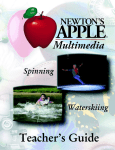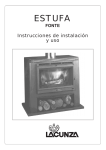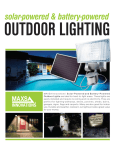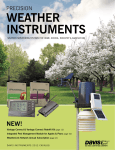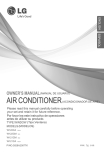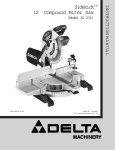Download DAVIS Fan-Aspirated Radiation Shield Installation manual
Transcript
Integrated Sensor Suite with Fan-Aspirated Radiation Shield For Vantage Pro2™ and Vantage Pro2 Plus™ Installation Instructions Addendum The Vantage Pro2™ Integrated Sensor Suite (ISS) with the Fan-Aspirated Radiation Shield uses a combination of fan-aspiration and shielding to minimize temperature measurement errors due to the effects of solar radiation. Fan-Aspirated ISS Addendum Overview This addendum provides additional information specific to the installation and use of ISS models containing the fan-aspirated radiation shield only, and is intended to be used in conjunction with the “Integrated Sensor Suite Installation Manual.” The table below shows the location of the information required to install and maintain your Fan-Aspirated ISS system. Section/Procedure In This Addendum Tools for Setup X Preparing the Anemometer X Preparing the Rain Collector X Preparing the Radiation Shield X Powering ISS and Testing Communications Powering and Testing the Fan In the ISS Installation Manual X X X Choosing a Site for the ISS X Mounting the ISS X Additional Mounting Options X Fan-Aspirated ISS Maintenance X Theory of Operation X Fan-Aspirated ISS Troubleshooting X Fan-Aspirated ISS Specifications X 1 Fan-Aspirated ISS Addendum Overview Components The Fan-Aspirated ISS includes these components: Rain Collector Debris Screen (place inside cone after installation) Metric Rain Adapter Solar Panel (wireless ISS only) Anemometer Vane Control Head SIM Housing Anemometer Base Drip Ring ISS Base Anemometer Arm Wind Cups Anemometer Cable 40' (12.2 m) Aspirated Radiation Shield The hardware shown here is provided for assembly and mounting: U-Bolts 1/4" Flat Washers 1/4" x 3" Lag Screws 1/4" Lock Washers 1/4" Hex Nuts Nut Plate #4 x 1-1/8" Machine Screw #4 Tooth Lock Washer #4-40 Hex Nut 8" Cable Ties 2 .05" Allen Wrench Tools for Installation Additional Components on Vantage Pro Plus Vantage Pro2 Plus™ includes an ultraviolet (UV) sensor and a solar radiation sensor. These two sensors are mounted next to the rain collector on your ISS UV and Solar Sensors Sensor Mounting Shelf See the Integrated Sensor Suite about mounting and maintaining these sensors. Do not to touch the small white diffusers on top of the UV and solar radiation sensors. Oil from the skin reduces sensor sensitivity. Tools for Installation Refer to this section in your ISS Installation Manual on assembling the anemometer. Preparing the ISS for Installation Refer to this section in your ISS Installation Manual on assembling the anemometer. Preparing the SIM for Installation The ISS sensors are connected by cables to the Sensor Interface Module (SIM), located inside the SIM housing. The SIM contains electronics that measure and store weather values for transmission to the console via radio. The SIM housing protects the SIM from the elements and provides easy access to SIM cable connections. See the ISS Installation manual on checking the sensor connections to the SIM and for any additional sensor and wireless installation instructions. Preparing the Rain Collector Follow these steps to prepare the rain collector for operation. 1. Remove the rain collector cone from its base by rotating the cone counter-clockwise until its latches line up with openings which allow you to lift it off. The cone fits in the base tightly and may require extra pressure to remove it when new. Note: Steady the base between your knees when you rotate the rain collector. 3 Preparing the Fan-aspirated ISS for Installation 2. Carefully cut and remove the plastic cable tie (usually black in color) that holds the two-sided tipping bucket mechanism in place during shipping. Tipping bucket mechanism Twist off the rain collector cone Cut the plastic cable tie Preparing the Rain collector Note: If installed, the UV and solar radiation sensor cables are routed through the base of the rain collector. Please make sure they do not get moved and make sure they do not interfere with the tipping bucket mechanism or with latching the cone back onto the base. See the ISS Installation Manual for instructions on inserting the optional metric measurement adapter. Preparing the Fan-aspirated ISS for Installation The radiation shield, fan, and solar panel used to power the fan come preassembled with the ISS unit and require no additional assembly. However, the fan requires initial power from the pre-installed batteries. Tabs are included to ensure that the batteries that are installed in the fan-aspirated housing do not power the unit during shipping. To power the fan-aspirated unit. 1. Remove the cardboard packing inserts between the passive shielding, the solar panel, and the rain collector base and discard. 2. Pull the tabs on the outside of the shielding slowly. 3. Listen for a slight whir coming from the bottom of the ISS unit. This sound signifies that the fan is running. 4 Applying Power and Testing Communications Applying Power and Testing Communications Powering the ISS and Testing Communication with the Console Refer to Wireless ISS Assembly section in your ISS Installation Manual for the rest of the procedures required to power and test the ISS. Locating the ISS and Anemometer Refer to this section in your ISS Installation Manual. Mounting the ISS The fan-aspirated version of the ISS, is mounted and installed just like the regular version of the ISS. Refer to this section in your ISS Installation Manual to mount the ISS. Additional Mounting Options Refer to this section in your ISS Installation Manual. Fan-Aspirated ISS Installation Options Batteries The Wireless Fan-Aspirated ISS is solar powered and is supplied with two NiCad C-cell batteries that come pre-installed. The following options for battery power exist: • Use two fan batteries for maximum length of overnight aspiration but with slightly lower average daytime aspiration. • Use only one fan battery for some overnight aspiration but with slightly higher average daytime aspiration. • Remove both batteries for maximum daytime aspiration and no nighttime aspiration. Fan-Aspirated ISS Maintenance • Keep the surfaces clean, since the Fan-Aspirated Radiation Shield is less effective when the surfaces are dirty. Remove dust from the solar panel and the shield with a damp cloth. • Remove any debris obstructing air flow through the radiation shield, e.g., leaves, twigs, webs, and nests. • Avoid spraying insect killer of any kind into the radiation shield as this may damage the sensors and the shield. • Once a year: replace the motor (Part # 7758), batteries, and remove any debris lodged inside the unit. Disassemble the Radiation Shield Disassemble the radiation shield for routine cleaning, maintenance, and to replace the batteries and motor. To disassemble the shield: 5 Fan-Aspirated ISS Troubleshooting 1. Remove the three screws connecting the rain collector base to the mounting bracket. 2. Lift the rain collector base off of the mounting bracket. Note: For easier re-assembly, mark the holes used by the rain collector base, the holes used by the radiation shield, and the orientation of the bracket relative to the radiation shield. 3. Remove the three (3) screws connecting the mounting bracket to the radiation shield. 4. Lift the mounting bracket off of the radiation shield. 5. Remove all debris from inside the shield and replace the batteries if necessary. Annual Maintenance 1. Retrieve your Fan-Aspirated ISS and place on a stable work surface. 2. Disassemble the radiation shield. 3. Unplug the old motor and remove from it from the Radiation Shield. 4. Install the new motor/fan assembly. Fan Unit Motor Connector Fan Deflecto Temp/Hum Sensor Cable Channel Junction Bo Fan Pla 5. 6. 7. 8. Remove the fan batteries. Install new batteries (NiCad C-cells). Assemble the Radiation Shield. Re-mount the Fan-Aspirated Radiation Shield in its previous location. #4 Screws Battery Cover Air Flow 1.2 Volt Nicad Battery O-Ring Battery Compartment Fan-Aspirated ISS Troubleshooting If you are experiencing problems with your Fan-Aspirated ISS, first be sure to check all cable connections. If you are unable to solve the problem, please call Davis Technical Support. We’ll be glad to help. Most questions can be answered while you’re on the phone. You can also e-mail us for support, or visit our website. Sorry, we are unable to accept collect calls. 6 Fan-Aspirated ISS Troubleshooting Note: Please do not return items to the factory for repair without prior authorization. Contacting Davis Instruments (510) 732-7814 for Technical Support, Monday – Friday, 7:00 a.m. – 5:30 p.m. Pacific Time. [email protected] E-mail to Technical Support. (510) 670-0589 Fax to Customer Service or Tech Support. www.davisnet.com Copies of User Manuals are available on the “Support” page. Watch for FAQs and other updates. Subscribe to the e-newsletter. Theory of Operation The diagram below shows how the Fan-Aspirated Radiation Shield draws outside air up through the sensor chamber and between the three walls surrounding the sensor chamber. MOTOR FAN SENSOR CHAMBER Cross-section of Fan-Aspirated Radiation Shield Fan-Aspirated ISS Specifications Aspiration Rate . . . . . . . . . . . . . . . . . . 190 ft./min. (.96 m/s) (solarpowered, full sun), 80 feet/min. (0.4 m/s) (battery only) Radiation-Induced Temperature Error. . 0.5°F (0.3°C) [At solar noon, insolation = 1040 W/ m2] 7 (Reference: RM Young model 43408) Operating Temperature . . . . . . . . . . . . –40° to +140° F (–40° to +60° C) Non-operating Temperature . . . . . . . . . –50° to +158° F (–45° to +70° C) ISS Primary Power Input Wireless ISS . . . . . . . . . . . . . . . . . . . . solar panel ISS secondary power . . . . . . . . . . . . . . CR-123A 3-volt lithium battery (8 months without sunlight to greater than two years depending on solar charging) Fan Primary Power Input Wireless ISS . . . . . . . . . . . . . . . . . . . . . solar panel Fan secondary power . . . . . . . . . . . . . . 1 or 2 - 1.2 Volt NiCad C-cells FCC Part 15 Class B Registration Warning This equipment has been tested and found to comply with the limits for a Class B digital device, pursuant to Part 15 of the FCC Rules. These limits are designed to provide reasonable protection against harmful interference in a residential installation. This equipment generates, uses, and can radiate radio frequency energy and, if not installed and used in accordance with the instructions, may cause harmful interference to radio communications. However, there is no guarantee that interference will not occur in a particular installation. If this equipment does cause harmful interference to radio or television reception, which can be determined by turning the equipment on and off, the user is encouraged to try to correct the interference by one or more of the following measures: • Reorient or relocate the receiving antenna. • Increase the separation between the equipment and receiver. • Connect the equipment into an outlet on a circuit different from that to which the receiver is connected. • Consult the dealer or an experienced radio/TV technician for help. Changes or modification not expressly approved in writing by Davis Instruments may void the warranty and void the user's authority to operate this equipment. IC: 378810-6328 EC EMC Compliance This product complies with the essential protection requirements of the EC EMC Directive 89/336/EC. Addendum, Fan-Aspirated ISS Installation Rev A Manual (November 10, 2004) Document Part Number: 7395.252 Product Number:6153, 6163 Vantage Pro® and Vantage Pro2™ are trademarks of Davis Instruments Corp., Hayward, CA. © Davis Instruments Corp. 2004. All rights reserved. Information in this document subject to change without notice.








